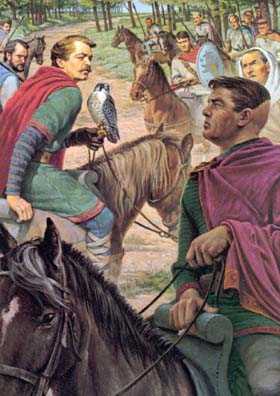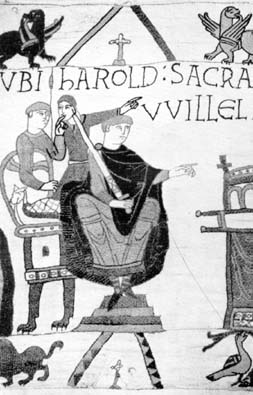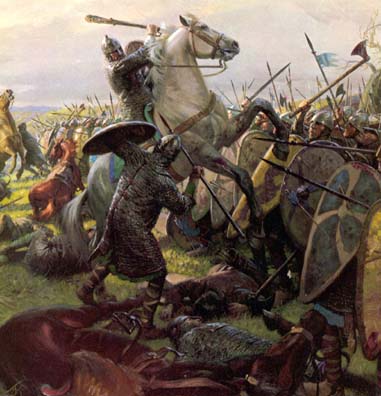| Childhood
Early Reign The Succession Issue 1066 and All That Who Was There? |
| Childhood
Early Reign The Succession Issue 1066 and All That Who Was There? |
Please visit the Sewell Genealogy Site Map for other pages.
Click to return to William the Conqueror in the Dukes of Normandy page.
William was the son of Robert, the 6th Duke of Normandy and his girlfriend Herleva. Robert and Herleva were both between seventeen and twenty years of age when William was born in 1028, and they never did get married. Robert set off on a pilgrimmage to the Holy Land in the autumn of 1034 and he died in early July 1035 at Nicaea in Asia Minor, about 65 miles south east of present day Istanbul, Turkey. William was left a six (nearly seven) year old illegitimate child in a cruel mediæval world.
Fortunately for William, his father had named him heir to the Dukedom of Normandy prior to his ill advised pilgrimmage. William's guardians were:
Most, if not all, youngsters fear that
something will "get" them in the night. For William, this fear was
a reality. He was only ten or twelve years of age, and this period
of his life must have been a very traumatic experience.
In 1046/47, Duke William's cousin Guy of Burgundy (son of William's Aunt Alice and Rainald, Count of Burgundy) tried to seize control of Normandy with the help of rebellious Norman lords, but Duke William defeated them with the assistance of King Henry (I) of France.
William then extended his influence
thoughout northern France and acheived a Flemish alliance with his marriage
to Matilda, a daughter of Baldwin (V), Count of Flanders. Click on
Matilda
for her descent.
 |
 |
|
|
on pork, mutton, fish, pheasant and bread. |
St. Edward the Confessor, King of England, died without children on January 5, 1066. Many sources indicate that St. Edward was Duke William's uncle, but this is not so. Their common ancestor was Richard (I) "the Fearless", 3rd Duke of Normandy (933 - 996). St. Edward was Richard's grandson and William was Richard's great grandson; thus St. Edward and William were first cousins once removed. However, St. Edward had lived in exile in Normandy during the reign of King Canute, he was older than William, and he doubtless seemed sort of like an "uncle" to the young William.
St. Edward had named William as his successor should either of them ever be able to claim the throne of England. When back on the throne, St. Edward married Eadgyth (Edith), a daughter of Godwine, Earl of Wessex. Godwin's son, Harold Godwineson, felt that as St. Edward's brother-in-law and as a person of Saxon-Danish ancestry that he should have the throne. However, he had sworn to support Duke William's claim during a visit to Normandy in 1064. Despite his promise, Harold Godwineson arranged to have himself crowned King of England on January 6, the day after St. Edward's death.
To further complicate the issue, King Harold Hardraada of Norway felt that he should be King of England due to his relationship with Sweyn Forkbeard and Canute. Another of Godwine's sons, Tostig Godwineson, supported him.
There was only one thing for for William
to do - - - invade England.
 |
 |
|
from the Bayeux Tapestry |
He chose a mace for a weapon so he might shed less blood. (Kenneth M. Setton (ed.): The Age of Chivalry, National Geographic Society, 1969, page 123). |
There has been lots written about the events of 1066, the Battle of Hastings, and all that stuff. For full details, try an encyclopædia or some of the links below.
Here is what happened in brief :
After nearly a thousand years, it is difficult to say with exact certainty who was present at the Battle of Hastings. Scholars of History seem able to agree on only about twenty-five or so persons as having been at Hastings for sure. However, it is widely accepted that between five thousand and twelve thousand persons accompanied Duke William, and almost all would have been at Hastings on October 14, 1066. A small number were likely left behind to guard other critical positions in England, and some highly trustworthy persons were left at various strongholds in Normandy.
Throughout these pages, I have identified various ancestors as having "accompanied William the Conqueror" or having been "present at the Battle of Hastings". In all cases, I have found this mentioned in some reliable source which is referred to on the page in question.
Here are some sources that are easy to check:
In our family, we are not overly concerned about this issue.
We say: "My ancestor was William the Conqueror".
The material on this page came from a variety of sources including:
Please visit the Sewell Genealogy Site Map for other pages.
Click to return to William the Conqueror in the Dukes of Normandy page.
(Copied from THE AMERICAN GENEALOGIST, October 1944 V. 21 No. 2 Pages 111 - 113)
In his review of “The Falaise Roll” in The AMERICAN GENEALOGIST, July 1939 (pp. 56-63), this writer pointed out that a list of the tenants who can actually be proved to have been present at the Battle of Hastings is a very small one and must be based upon the named figures in the Bayeux Tapestry and upon William of Poictiers and Guy of Amiens, and the naming of certain persons by Orderic Vitalis, about whom he may be presumed to have had special knowledge. He further stated that the names recorded in the Roman de Rou of Robert Wace, the Battle Abbey Roll and its derivatives, the Dives Roll and the Falaise Roll cannot be accepted as proof of a man’s presence at the battle. He further pointed out that from certain other evidence a second list might be compiled of persons who were most probably present and expressed the hope that such lists would be compiled at some future dale.
It is very gratifying to be able to state that two such lists have at last been compiled by Prof. David Douglas and have been printed in an English Periodical called “History” for September 1943 (pp. 129-147) and it is a matter of satisfaction to note that Prof. Douglas has, quite independently, worked along the lines suggested in the review. The first list of those whose presence at the battle is assured, and which is in all probability final, consists of twenty-seven names. The second list of those who were probably present is based upon charter evidence, i.e., those who attested Duke William’s charters under circumstances which renders it most probable that they took part in the expedition. This writer was pleased to note that among these names Prof. Douglas lists Pons and suggests that he may be the progenitor of the Cliffords, as was suggested in the aforementioned review and still earlier in a note in the Genealogical Department of the "Boston Transcript". Prof. Douglas points out that his second list will probably be enlarged after an intensive and critical study has been made of the Norman charters, a thing which has not yet been done.
As these lists of Prof. Douglas are based upon evidence,
which, to this writer, seems conclusive it seems well to place them before
the American genealogical public, as ones upon which there may he complete
reliance.
List of those who were certainly at Hastings:
(* indicates those from whom descent can be traced.)
* Eustace Count of Boulogne.
* Robert
Count of Mortain.
* WilIiam, son of Count Richard of Evreux.
* Geoffrey, son of Rotrou, Count of Mortagne anti Perche.
Odo, Bishop of Bayeux.
Geoffrey, Bishop of Coutances.
* William
fitz Osbern.
* Aimeri,
Vicomte de Thouars, the Poictivin.
* Walter
Giffard.
* Ralf de Toeni.
* Hugh de Montfort.
* Hugh de
Grantmesnil.
* William
de Warenne.
* Robert,
son of Roger de Beaumont.
* William Malet.
Gulbert d’Affray.
Robert de Vitot.
* Engenulf de 1’Aigle.
Gerelmus de Panileuse.
(*?) Robert fitz Ernis.
Roger, son of Turold.
Turstin, son of Rou.
Erchembald, son of Erchembald the Vicomte.
Vitalis.
* Wadard.
Taillefer.
A member of the house of Ponthieu (“Pontivi nobilis haeres”).
Perhaps Count Gui I.
List of those witnessing Norman charters under circumstances
which render it most probable that they accompanied time expedition:
* Gerald the Seneschal (grandfather of William de Roumare).
* Rodulf the Chamberlain (? de Tancarville).
Hugh d’Ivry, the Pincerna.
* Richard
fitz Gilbert (de Clare).
* Pons (? ancestor of the Cliffords).
In addition to these the following, who witnessed Duke William’s charter made at Caen on 17 June 1066 (Gall. Christ. XI, Instr. col. 59), were, I think, most probably at Hastings:
* Richard the Vicomte of the Avranchin (father of Hugh Lupus).
* Ranulf the Vicomte of the Bessin.
* Ralf Tesson.
* Fulk d’Aunou.
* Those from whom descent can be traced.
(Copied from THE AMERICAN GENEALOGIST, October 1944 V. 21
No. 2 Pages 111 - 113)
Click to return to the top of this page.
Please visit the Sewell Genealogy Site Map for other pages.
Click to return to William the Conqueror in the Dukes of Normandy page.